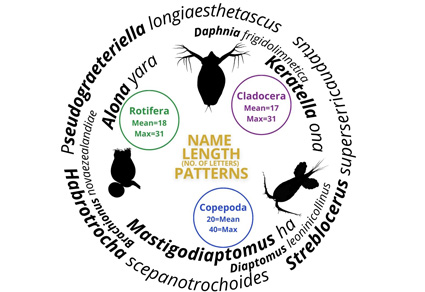Abstract
The motivations for describing species are multifaceted and extend beyond the scientific disciplines, promoting public engagement and enhancing biodiversity communication. We delve into the practices of naming species of Rotifera, Diplostraca (= Cladocera) and Copepoda, underpinning the effects of time, taxon group and the lengths of genus names on the length of specific names. Our investigation revolves around a comprehensive dataset comprising 6319 names described between 1758 and 2021 of Rotifers, Cladocera and Copepoda. The overall annual average hovers around a mean length of slightly over 10 and 8 letters, respectively, for genus names and specific names, although it varied noticeably across taxa. Notably, our findings reveal no substantial temporal variation in the length of specific names over the years of description. We found a positive although not significant relationship between the length of specific and genus names, suggesting that longer genus names may influence the choice of longer specific names. We support the recommendation by the International Commission on Zoological Nomenclature and existing related publications on this topic, to prioritize short names, emphasizing the importance of concise and ultimately the use of mnemonic names assigned to zooplankton species.
References
- Bates, D., Mächler, M., Bolker, B. & Walker, S. (2015) Fitting Linear Mixed-Effects Models Using lme4. Journal of Statistical Software, 67. https://doi.org/10.18637/jss.v067.i01
- Bolker, B.M., Brooks, M.E., Clark, C.J., Geange, S.W., Poulsen, J.R., Stevens, M.H.H. & White, J.-S.S. (2009) Generalized linear mixed models: a practical guide for ecology and evolution. Trends in Ecology & Evolution, 24, 127–135. https://doi.org/10.1016/j.tree.2008.10.008
- Corgosinho, P.H.C., Arbizu, P.M. & Dos Santos-Silva, E.N. (2010) Revision of Brasilibathynellocaris Jakobi, 1972 (Copepoda: Harpacticoida: Parastenocarididae) with redefinition of the genus. Zoological Journal of the Linnean Society, 159, 527–566. https://doi.org/10.1111/j.1096-3642.2009.00574.x
- Dybowski, B.N. (1926) Synoptisches Verzeichnis mit kurzer Besprechung der Gattungen und Arten dieser Abteilung der Baikalflohkrebse. Bulletin of the Polish Academy of Sciences, Scientific Letters, 1–77.
- Eilers, P.H.C., Marx, B.D. & Durban, M. (2015) Twenty yearsof P-splines. SORT, 3, 149–186.
- Garbino, G.S.T. (2023) Rethink changing species names that honour real people. Nature, 616, 433–433. https://doi.org/10.1038/d41586-023-01276-7
- Gillman, L.N. & Wright, S.D. (2020) Restoring indigenous names in taxonomy. Communications Biology, 3, 609. https://doi.org/10.1038/s42003-020-01344-y
- Guedes, P., Alves-Martins, F., Arribas, J.M., Chatterjee, S., Santos, A.M.C., Lewin, A., Bako, L., Webala, P.W., Correia, R.A., Rocha, R. & Ladle, R.J. (2023) Eponyms have no place in 21st-century biological nomenclature. Nature Ecology & Evolution, 7, 1157–1160. https://doi.org/10.1038/s41559-023-02022-y
- Hulme, P.E. & Mclaren-Swift, H. (2022) Declining readability of research on biological invasions over two decades. Biological Invasions, 24, 1651–1660. https://doi.org/10.1007/s10530-022-02740-7
- International Commission on Zoological Nomenclature (ICZN) (1999) International Code of Zoological Nomenclature. 4. ed. The International Trust for Zoological Nomenclature 1999. Available from: https://www.iczn.org (accessed 1 September 2023)
- Jasper, P.D., Froehlich, E.M. & Carbayo-Baz, F.J. (2021) A study on the etymology of the scientific names given to planarians (Platyhelminthes, Tricladida) by Ernest Marcus’ school. Papéis Avulsos de Zoologia, 61, e20216105. https://doi.org/10.11606/1807-0205/2021.61.05
- Jozwiak, P., Rewicz, T. & Pabis, K. (2015) Taxonomic etymology – in search of inspiration. ZooKeys, 513, 143–160. https://doi.org/10.3897/zookeys.513.9873
- Letchford, A., Moat, H.S. & Preis, T. (2015) The advantage of short paper titles. Royal Society Open Science, 2, 150266. https://doi.org/10.1098/rsos.150266
- Macêdo, R.L., Elmoor-Loureiro, L.M.A., Sousa, F.D.R., Rietzler, A.C., Perbiche-Neves, G. & Rocha, O. (2023) From pioneers to modern-day taxonomists: the good, the bad, and the idiosyncrasies in choosing species epithets of rotifers and microcrustaceans. Hydrobiologia, 850, 4271–4282. https://doi.org/10.1007/s10750-023-05302-7
- Mammola, S., Viel, N., Amiar, D., Mani, A., Hervé, C., Heard, S.B., Fontaneto, D. & Pétillon, J. (2023) Taxonomic practice, creativity and fashion: what’s in a spider name? Zoological Journal of the Linnean Society, 198, 494–508. https://doi.org/10.1093/zoolinnean/zlac097
- Plavén-Sigray, P., Matheson, G.J., Schiffler, B.C. & Thompson, W.H. (2017) The readability of scientific texts is decreasing over time. eLife 6. https://doi.org/10.7554/eLife.27725
- Poulin, R., de Angeli Dutra, D. & Presswell, B. (2022) Short and sweet: an analysis of the length of parasite species names. Systematic Parasitology, 99, 699–706. https://doi.org/10.1007/s11230-022-10058-0
- R Core Team (2023) R: a language and environment for statistical computing. R foundation for statistical computing, Vienna. Available from: https://www.R-project.org/ (accessed 1 September 2023)
- Rummy, P. & Rummy, J.T. (2021) Recontextualising the style of naming in nomenclature. Humanities and Social Sciences Communications, 8, 283. https://doi.org/10.1057/s41599-021-00975-8
- Sienkiewicz, J. & Altmann, E.G. (2016) Impact of lexical and sentiment factors on the popularity of scientific papers. Royal Society Open Science, 3, 160140. https://doi.org/10.1098/rsos.160140
- Šlapeta, J. (2013) Ten simple rules for describing a new (parasite) species. International Journal for Parasitology: Parasites and Wildlife, 2, 152–154. https://doi.org/10.1016/j.ijppaw.2013.03.005
- Wickham, H., (2016) Ggplot2: Elegant Graphics for Data Analysis. Springer, New York, XVI + 260 pp. https://doi.org/10.1007/978-3-319-24277-4
- Wood‐Charlson, E.M., Bender, S.J., Bruno, B.C., Diaz, J.M., Gradoville, M.R., Loury, E. & Viviani, D.A. (2015) Translating Science into Stories. Limnology and Oceanography Bulletin, 24, 73–76. https://doi.org/10.1002/lob.10055
- Wood, S.N. (2017) Generalized additive models: an intro-duction with R. 2nd ed. Chapman and Hall/CRC, Boca Raton, 496 pp.


